Siamese cyberAquarium Limited Partnership
![]()
The story of Betta smaragdina
Introduction
In the past few years I have heard often about the fighting fish in the North Eastern of Thailand call “ISAN”. With a very busy in business life, my schedule plans to visit ISAN were cancelled many times. A tragedy was when I free in the last quarter of the year the fighting fish game already over. (The fighting fish game begins every year in March and an end in September, the rainy season or growing rice period). My plan to visit ISAN to experienced fighting Betta smaragdina was immediate set up on 4 – 6 August 2000, after a few discussion with a new friend whose came in through a lines of ICQ. The following was a refinement story of my exciting experience got from observing Plakat Thai in ISAN, the land of ancient richest cultural heritage.
The term “Plakat Thai” and “Siamese fighting fish” have the same
meaning. The different only “Plakat Thai” is Thai language whereas “Siamese
fighting fish” is English language (Plakat = biting/fighting fish, Thai =
Siamese). Plakat Thai can classify into three Betta species, Betta splendens,
Betta smaragdina and Betta imbellis. Betta splendens is the most famous and
most active demand of all among three species. Amazingly all three
species, in the past, Thai farmer learn how to develop them to be the fighting
fish. No one can tell which specie came first. I believe that all three species
were developed locally along together. And also the THREE were interbred as a
triangle shape that the Betta splendens was the topside. This was done through
the mean of fighting fish activity, which play very significant role to bring
about interbreeding of these three Betta species call Plakat Thai.
Geographical
breeding place of Plakat Thai
Thailand graphically composed of five parts Northern, North Eastern, Central part, Eastern and Southern. There are breeding places of Plakat Thai in every part of the country, to be more precisely you can find breeding places in every provinces of Thailand. Each part has own domestic specie and is stressed one specie more than another. North Eastern breed mainly Betta smaragdina, Central part breed mainly Betta splendens. Southern part breed Betta imbellis and Betta splendens active to an entire year.
Thailand Map
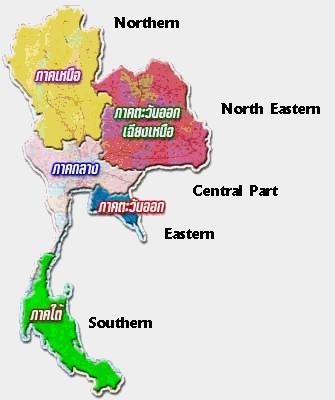
There are very few Betta breeders in the topmost of the Northern part. Geographically Northern is consisting of highland and complex ranges of mountains. The weather is slightly cold to an entire year. The cold weather is not good for breeding Betta. There is only short period of March to May is sunny. But wild Betta splendens and Betta smaragdina can be found in the rice field and the surrounding area. However there are many breeding places in a lower part, which is a graphically basin and be a junction of many rivers come from the North. A non-vary temperature with the fertilize soil very suitable for cultivate live food for Plakat Thai, the most essential factor of successful breeding the good stock.
The North Eastern part favors Betta smaragdina especially the provinces that connected to the river Khong, the Thai/Lao border. The breeders preserve the traditional fighting fish game that is an enjoyment after work. There is no commercial breeding purpose or if any, there is very few. The fishes are caught in the wild and exchange among the close friends. The fishes are free backs to rice field after a game is over.
Every province in the Central part and Eastern part is stress mainly on Betta splendens, long fin and short fin. Bangkok or official name “Krung Thep” a capital of Thailand, is the center of all kind of ornamental fish trade but Betta splendens is a major.
Southern part has two species, Betta splendens and Betta imbellis. With the rainy climate, breeding Betta is suitable in all aspects. Like breeders in the North Eastern, the breeders do breed Betta imbellis for seasoning enjoyment and do not care much in quantity. I will discuss breeding Betta imbellis in a separate home page section.
For winning a game in domestic fighting fish, some breeders crossbreed the domestic specie with cultivated Betta splendens. For example, the breeders of the North Eastern crossbreed his wild caught Betta smaragdina with cultivated Betta splendens and of course the breeders of Southern doing crossbreed his wild caught Betta imbellis with cultivated Betta splendens.
In this section I am focusing only the Betta smaragdina, the first aquarium pet of ISAN people. Keeping, rearing and fighting of Betta smaragdina is the traditional hobby that involving the basic dynamic social life and goes along with the ISAN culture for a long time. The traffic of Thai cultures is gradually lead to interchanging of Betta breeding bloodlines.
North Eastern of Thailand Map
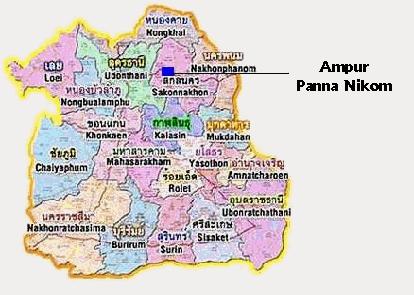
What
is Betta smaragdina?
Betta
smaragdina is one species in Betta family, available in North Eastern of
Thailand and Lao. The general characteristic of the fish is, the scale and
cover gill are shinny crystal green color. The trunk is round form when look by
side, tiny slim when look from above. The pelvic fin is grandeur tapering long.
Caudal fin and anal fin has slightly orange color. The Dorsal fin has green
color. The local people call Betta smaragdina Is "Green fighter" or
" Plakat Keaw" or "Pla Keaw". The size by average is 1.5 –
2 inches, shy and be frightened to any stranger that come to approach.
Betta
smaragdina's Natural
Habitat
Betta
smaragdina is the native fighting fish of ISAN. The areas of
ISAN consist of one third of the entire country mostly a plateau high land.
This geographical characteristic is isolating and preserving the pure breed of
Betta smaragdina not to be mixed with other Betta species. The Betta
smaragdina
like Betta splendens can be widely found living in the shallow
rice paddies, ditches and the low land space beside the rice field. This
buffer area is the free space that farmers leave it for release and drawing up
water from/to his rice field. Therefore naturally this area is flooded an
entire year, except in the really dry season it could be remain only the wet
mud.
Because of farmer do not use this area for growing rice so it is untouched from any chemical spray. The small area is complex and complete in itself. There are various kinds of plants mixed up such as weed, flooded plant, varieties of grass and wild plant. There are also various wild animals reside in this area.
 This small
area has a specific
set of role to the farmer life. It is the direct source of food, eatable plant
and fishes. For children, this is their playground
paradise. It is the place of theirs’ adventure, the classroom to learning
the way of nature. The place for running around catching to each others, some
of them may searching for small fish and of course one of them is Betta
smaragdina "THE GREEN FIGHTER",
This small
area has a specific
set of role to the farmer life. It is the direct source of food, eatable plant
and fishes. For children, this is their playground
paradise. It is the place of theirs’ adventure, the classroom to learning
the way of nature. The place for running around catching to each others, some
of them may searching for small fish and of course one of them is Betta
smaragdina "THE GREEN FIGHTER",
the fighter of North Eastern of
Thailand.
Catch the wild fighter with tenderly scoop of
hands
To catch other
wild fishes we may have to use massive net throwing into the pond and slowly
pulling back. An unlucky fish get stick in the net, then the fisherman slowly
loosens a fish from the tousled net and throw a fish into the bamboo
cage. The fish is his food.
Catching Betta smaragdina is entirely different. The catching method is so smooth without noise or violence. To get this fish out from the wild there is no requirement of special fishery instrument, only two hands are needed. It seems that the green fighter is available there and just waiting for someone to get him or her out from the wild to the new home.
 If a
boy want to have a green fighter he just walking through the pave way, the
preserve space between the rice field and the flooded land. With his
experiences he is slowly scanning his eyes to the location that the green
fighter should reside at.
If a
boy want to have a green fighter he just walking through the pave way, the
preserve space between the rice field and the flooded land. With his
experiences he is slowly scanning his eyes to the location that the green
fighter should reside at.
 Without any
hurry, he slowly step his bare feet in the water deep only 10 inches. He is
directing to the target place. With very careful, he is slowly opens the wild
grass. His eyes are scanning intensively for the bubble nest, the very high
percentage he should found the small bubble nest of the green fighter.
Without any
hurry, he slowly step his bare feet in the water deep only 10 inches. He is
directing to the target place. With very careful, he is slowly opens the wild
grass. His eyes are scanning intensively for the bubble nest, the very high
percentage he should found the small bubble nest of the green fighter.
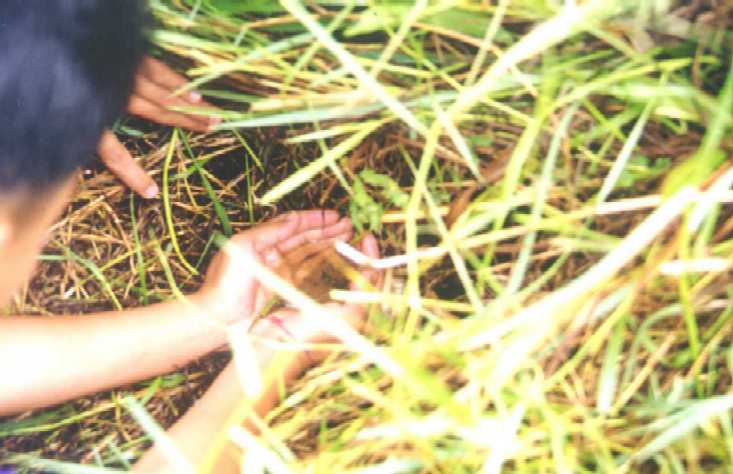 A boy slowly opens the grass on all sides of the
Betta’s bubble, he lower and bend down himself. Without hurry he do tenderly
hollow the palm of his hands and careful raising the fighter to the new home.
A boy slowly opens the grass on all sides of the
Betta’s bubble, he lower and bend down himself. Without hurry he do tenderly
hollow the palm of his hands and careful raising the fighter to the new home.
The fighting fish
Betta smaragdina
One of the green fighting fish breeder in SakonNakorn province I met in the fighting fish ring told me that the fighting fishes in ISAN may lead back over 200 years. He has 53 years old. He said that his father told him that his grandfather was the big player of fighting fishes game. From his personal opinion, the fighting fish may came along with the fighting cock or even before. To validate his opinion he said that in the past or even today Thais life has very close relationship to the water. We were riverside society. Over 80 percent of Thai people were the farmers. The life so closed to the nature, depending on growing rice caught fish for cooking, the children playing and caught the small fishes in the rice field. So we should knew fighting fish before knew fighting cock. This answering theme was very similar to the 45 years old idea, owners of a local aquarium shop in “U Bon Rat Cha Tha Ni” province, the 119 kilometers from SakonNakorn. I am quite inclining to theirs’ explanation. However, at this moment I am temporary break off the searching an origin of fighting fish in the North Eastern of Thailand only this point. I hope by doing deep research in the literature review I could go into the deeper explanation with some objective primary source support.
The fighting fish may regularly takes place at any one member’s house. Normally the match held on Saturday and Sunday. The starting time is about 10 A.M. with some few people but they will come to join an event more lately. The starting time is so late because people should finish theirs daily work before to join the playful game. People are gathering themselves around the bottle that using for the fishes fighting. A square tall glass is held at the center of the group of people. This grouping manner is a symbol representing a community and unity of the people of ISAN. The fighting fish play very significant role as an agent of social interaction among people in the weekend. No matter of workload and depression during a week was, in the group they are laughing, talking loud with a happiness face.
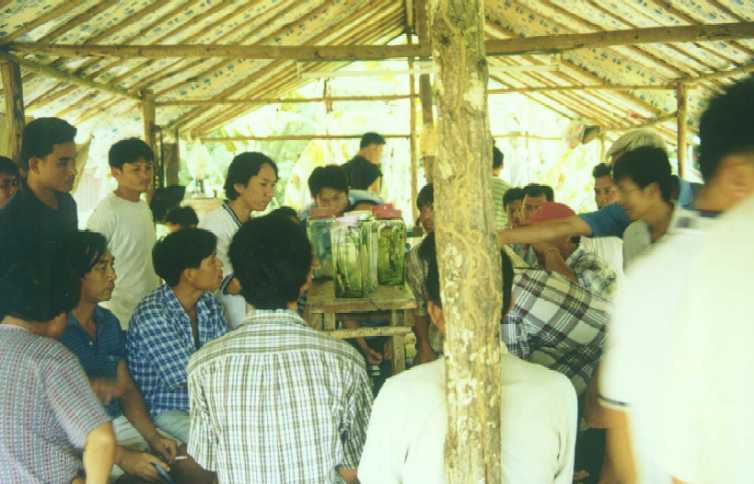 Unlike fighting
Betta splendens using a dipper
with a spoon of water to shift the fish to the fighting bottle, the fighting
Betta smaragdina to be fair, an owner of the fighter using small net shifting
his fighter from his glass to the fighting bottle. This is to prevent playing
trick for any chemical solution from the water of each bottle of an owner. Once
a second fighter has lower into the fighting bottle, the challenger who has
already waiting him there immediately open splendid crystal green cover gills
rush to another like the fly allow. Then both flaring its fin to threaten and
deceiving for its opponent that he is bigger, being more powerful and even more
aggressor. With a very dignified, they are swimming around in a rotating
manner. Theirs eyes are fixedly to another and flaring theirs’ fin scary to its
opponent. But none afraid to another, suddenly one of them attacking to
another likes a flash and turn back to flaring to showing off his superpower,
then another do payback at once.
Unlike fighting
Betta splendens using a dipper
with a spoon of water to shift the fish to the fighting bottle, the fighting
Betta smaragdina to be fair, an owner of the fighter using small net shifting
his fighter from his glass to the fighting bottle. This is to prevent playing
trick for any chemical solution from the water of each bottle of an owner. Once
a second fighter has lower into the fighting bottle, the challenger who has
already waiting him there immediately open splendid crystal green cover gills
rush to another like the fly allow. Then both flaring its fin to threaten and
deceiving for its opponent that he is bigger, being more powerful and even more
aggressor. With a very dignified, they are swimming around in a rotating
manner. Theirs eyes are fixedly to another and flaring theirs’ fin scary to its
opponent. But none afraid to another, suddenly one of them attacking to
another likes a flash and turn back to flaring to showing off his superpower,
then another do payback at once.
Betta smaragdina is less swinging its body to push away its opponent (in Thai boxing term call “Tec” or kicking to another) comparing to Betta splendens that trying to push its opponent to be lose of control. The fight of Betta smaragdina is more artistic and more stylistic like traditional wrestling, a playing game not a killing game. After a game both of them not injure much. And turn to be normal as before fight within one or two days without any assisting drop of medicine.
The fighting ends about half an hour and if they fight till to an hour and none run away. The judge will call the owner to take off his fish from the fighting bottle, this mean they are ties. By average the fight take only 15 minutes. Some matches take only 5 to 10 minutes and one of them run away with a very few damage. The loser is freed back to the rice field, the winner can fight again after recover about a week. Very interestingly the winner can develop his fighting skill and doing better in the next fight.
The
game takes place seasoning from March to September, the period of growing rice
and full of water. Either winners or losers, the fighters were released back to
theirs’ nature after the game season over, waiting for the next year.
Breeding
technique of Betta smaragdina fighting strain
The breeding philosophy of Betta smaragdina fighting strain is "to preserve the characteristic of a stock as close as to its original that first found in the wild. To accomplish this, breeders do imitate the Smaragdina natural environment by release the bred fry back to its own nature. The release will do secretly only at night. The breeder does not want his opponent knows the source of his fighter. (An opponent may secretly catch some sample to try with his fighter). The wild environment slowly instructs the human selective bred to be the real wild tough Betta smaragdina. The struggles for life to living with the various hunter creatures gradually cultivate the green fighter how to fight and maintain its territory. Only the strongest are survived. The weaker shall be diminished. This is the natural selection. The wild environment will shape its structure as close as to its ancestor. The difference only they are not a natural selective bloodlines but human controlled breeding bloodlines. For precisely, they are hybrid of Betta smaragdina and Betta splendens. They are like Arnold’s Terminator, the new strain selective fighter revival.
The breeding fighting strain of
Betta smaragdina
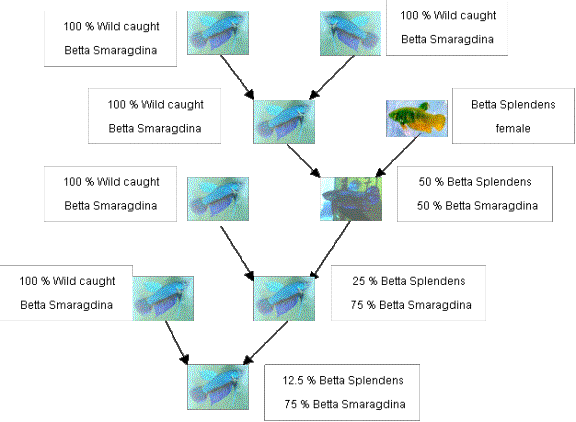
From
an above breeding framework, one can see that the breeders try to shape the
fighting fish strain as close as to its origin. For winning game purpose,
the breeders have introduced the Betta splendens fighting strain bloodlines
into the Betta smaragdina. The outcome of the crossbreed is the stock of
Betta smaragdina fighting strain. One hardly points out the difference between
the two, a Betta smaragdina fighting strain and the wild caught Betta
smaragdina. However, there are 3 main points that one may figure out, the
breeder told me.
One, the skull of selective green fighter is thicker and firmer whereas the wild caught is small and look balance with its own slim shape of body. Two, the lips of a human bred green fighter is thicker and sharpen form whereas the wild caught is fine. Three, the color of a human bred green fighter is rather deep dark color and the fin color is not so clear-cut where as the color of wild caught is faded but shine and crystal. The genius breeder is the one who can breed the fighter that has its structure form and colors as close as the wild caught one.
The
paradigm of breeding Betta Smaragdina to the development of Betta splendens
Based on scientific method, Ichthyologists have named each species of Betta from its differentiation. In the past Thai breeders, without any scientific knowledge and the modern educational support, they classified the fighting fish only two types, Plakat Pah or Wild caught fighting fish and Plakat Morh (fighting fish in earthenware pot) or cultivate fighter. This naming was based on its source, the fish can be found. This naming method was common to everywhere all over the world in the farmer society. The breeder in the Central part was successfully develop Plakat Pah (which was wild caught Betta splendens) continuously to be Plakat Morh and extending to produce the new strain as long fin Siamese fighting fish. This admires innovation of selective fish strain through social practice has to be praised alone to the Thai farmer, who has no study in the classroom.
Because when we think that we knowing something, that knowing turn to block our mind. So normally we will not do outside what we know. But Thai farmers do not know the different between the Betta's species. So they try to breed the fish to be the better fighter. I have been interview the old man asked him what is the characteristic of Plakat in the Southern of Thailand. He said that Plakat in the Southern part call “Pla Tai” (“Pla” mean fish, “Tai” mean Southern) is small size and dark brightly green scale (Betta imbellis). Where as Plakat ISAN is green scale and shy (Betta smaragdina). But Plakat in the Center part is brown pale colors (Betta splendens).
(To be continued)
![]() precha@asiaaccess.net.th
precha@asiaaccess.net.th
[ Main
] [ Who
Am I ? ] [ Sale
and Shipping Information
] [ The
Story of Plakat Thai ] [
The story of Betta
Smaragdina ] [ Dr.
Smith and Plakat Thai ]
[ Betta
Kombat ] [ Breeding
the Fighter ] [ Types
of Plakat Thai ]
[ From
the Pond to Bottle
] [ Fitting
your fish ]
[ Good
Pattern of Plakat Thai
] [ Betta
Tips ]
[ Gallery
] [ Show
Room ] [ Guest
Book 1 ] [ Guest
Book 2 ]
Siamese cyberAquarium
Ó All rights reserved
No
part of this publication may be reproduced, stored in a retrieval
system, or transmitted, in any form or by any means, electronic,
mechanical, photocopying, and recording or otherwise, without the
prior permission of
Siamese
CyberAquarium Limited Partnership
This Betta WebRing Site is owned by Precha Jintasaerewonge. |
|
[ Ring Info ] [ Next ] [ Skip Next ] [ Previous ] [ Random ] [ Skip Previous ] [ Next 5 ] [ List Sites ] |